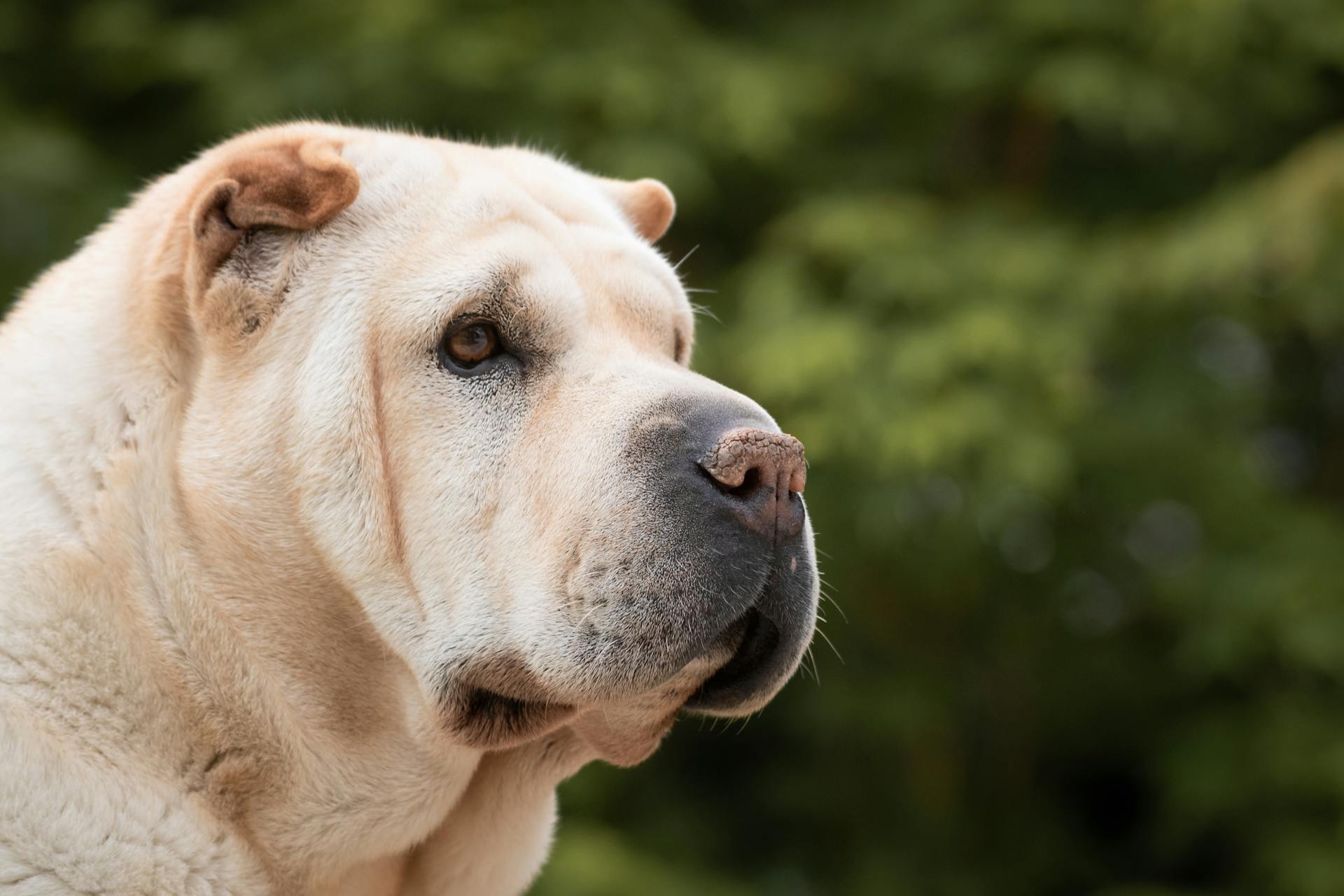
Lumps on dogs can be unsettling, but it's essential to understand that not all lumps are cancerous. The American Animal Hospital Association notes that up to 25% of dogs will develop lumps or masses at some point in their lives.
Most lumps on dogs are benign, but a small percentage can be malignant. According to the Veterinary Information Network, about 5-10% of lumps are cancerous.
If you've noticed a lump on your dog, it's crucial to have it checked by a veterinarian as soon as possible. A veterinarian can examine the lump and determine whether it's cancerous or not.
Your veterinarian may perform a fine-needle aspiration or biopsy to collect a sample of cells from the lump for further examination. This is usually a quick and relatively painless process.
Causes and Types of Lumps
Lumps and bumps on your dog can be caused by a variety of things, including fat, tumors, cysts, infection, and allergic reactions.
Some lumps can be serious, while others are less serious. Your veterinarian can't tell what type of lump is growing just by feeling it, with the exception of allergic reactions and abscesses.
A hernia occurs when one tissue or organ protrudes through another into an abnormal place on the body, often causing a lump or bump.
Many lumps, both serious and less serious ones, can feel and look identical.
Don't assume that a lump is just another lipoma, even if your dog has had multiple benign masses in the past.
Detection and Diagnosis
Detecting cancer in dogs is a multi-faceted process that relies on a veterinarian's expertise and your vigilant observation. Your veterinarian will conduct a comprehensive physical examination, feeling your dog's entire body and checking for any enlarged organs or masses.
A physical examination and history assessment are essential in detecting signs of cancer in dogs. Your veterinarian may detect hidden tumors through rectal and oral exams.
Diagnostic imaging, such as X-rays and abdominal ultrasounds, can help bring abnormalities to light. Your veterinarian may also palpate your dog's lymph nodes to check for any enlargement, which can be a sign of cancer.
Laboratory testing, including blood work, can give veterinarians an idea of what may be going on in your dog's body. Abnormal blood work is not always a sign that your dog may have cancer, but it does warrant further investigation.
Here are some common methods veterinarians use to diagnose cancer in dogs:
- Physical Examination and History Assessment
- Diagnostic Imaging (X-rays, abdominal ultrasounds)
- Palpation of Lymph Nodes
- Laboratory Testing (blood work)
Early detection of dog cancer is crucial for successful treatment and improved outcomes. If we find cancers early, we can treat them better, just as with people. We can diagnose them quickly and get the treatment started quicker, and hopefully, that will mean that the prognosis is much better.
Common Types of Lumps
Skin cancers are a common cause of lumps and bumps on dogs. They can be seen as lumps and bumps on the skin, or even hidden underneath the fur.
If this caught your attention, see: Lump under Skin after Dog Bite on Dog
Mast cell tumors are the most common form of skin cancer in dogs, and they can feel solid and firm to the touch. They can be irregularly shaped, rather than the expected rounded bump.
Some other types of lumps and bumps on dogs can be caused by fat, tumors, cysts, infection, allergic reactions, and swelling from injury or hernia. It's worth noting that a veterinarian can't always tell what type of lump is growing just by feeling it alone.
Benign Tumors
Benign tumors are a common type of lump found on pets. They are non-cancerous growths that can appear anywhere on the body.
Benign tumors can be soft, round, and movable, like lipomas. These are usually found on middle-aged to senior dogs who are overweight, particularly around the ribs.
Some benign tumors may not need to be removed immediately. Your veterinarian will consider the location of the mass on your pet's body, its size, and whether it's causing any discomfort or problems.
Recommended read: Benign Lump on Dog
If a benign tumor is not causing any issues, it's recommended to monitor its growth periodically. Even though it's benign, it can slowly grow and become troublesome to your pet.
Your veterinarian will be able to help you decide whether or not to remove a benign tumor. They will consider factors such as the mass's location, size, and whether it's causing any pain or irritation.
Here are some factors to consider when deciding whether to remove a benign tumor:
Remember, it's always best to consult with your veterinarian to determine the best course of action for your pet's specific situation.
Explore further: Best Homemade Food for Dogs with Cancer
Hematomas
A hematoma is a raised bruise on the surface of your dog's skin that can be painful when touched.
It's usually caused by direct trauma to that part of their body.
A hematoma isn't necessarily something you'd need to worry about for your dog's health, but it's always a good idea to have it checked out by a vet to make sure there aren't any hidden injuries, like a broken bone, beneath the bump.
Mast Cell Tumors
Mast Cell Tumors are a common form of skin cancer in dogs, and they can appear anywhere on the skin or even on internal organs.
Mast cell tumors can grow on the limbs, lower abdomen, and chest, and they're most often seen in certain breeds like boxers, pugs, Rhodesian ridgebacks, and Boston terriers.
These tumors can be solid and firm to the touch, and they can be irregularly shaped rather than the expected rounded bump.
They can also be hidden by the dog's fur, making them harder to detect.
A veterinarian will likely recommend a surgical removal of the affected tissue as well as a small border layer around it to make sure that all of the cancerous cells are removed.
Early detection and treatment are key, and with prompt action, your pup can be back on the move in no time.
Here are some common sites where mast cell tumors tend to appear:
- Limbs
- Lower abdomen
- Chest
Enlarged Lymph Nodes
Enlarged lymph nodes can be a sign of an underlying health issue in your dog. They can be found in various areas of your dog's body, including under the jaw or in the armpit.
Lymph nodes can swell due to an infection or a more serious condition, such as canine lymphoma. It's essential to have any swelling checked out by a vet as soon as possible.
Noticing a swollen lymph node can greatly improve your dog's chances of easy treatment. If you suspect a swollen lymph node, don't hesitate to schedule a vet visit.
Common places to find an enlarged lymph node include lumps on the neck under the jaw or a lump in the armpit.
Enlarged lymph nodes can be a sign of many different health troubles, so it's crucial to have them checked out by a vet.
For another approach, see: My Dog Has a Lump under His Chin
Squamous Cell Carcinoma
Squamous Cell Carcinoma is a common type of skin cancer in dogs. It typically affects older animals.
This form of skin cancer is often seen in breeds like dalmatians, beagles, whippets, and white bull terriers. These breeds may be more prone to developing squamous cell carcinoma.
Squamous cell carcinoma typically appears as raised wart-like patches or lumps that are firm to the touch. It's most often found on the dog's head, lower legs, rear, and abdomen.
Exposure to the sun may be a contributing factor to squamous cell carcinoma. There's also a possible link to papillomavirus.
For your interest: Dog Breeds Watch Dogs
Malignant Melanoma
Malignant melanoma is a serious health threat for dogs, and it's essential to be aware of the signs and risks. Most melanomas are benign, but malignant melanomas grow quickly and can spread to other organs.
Malignant melanomas are typically raised bumps that can be dark-pigmented, but not always. They're frequently found around the dog's lips, mouth, and nail bed.
Schnauzers and Scottish terriers seem to face an increased risk of developing melanoma, and male dogs are more at risk than females.
Treatment and Management
Surgical options are certainly available for dogs with cancer, and can be a viable choice for many pets.
Chemotherapies are also available, and we have many excellent treatments that can prolong a high quality of life for your dog.
Every case is different, and the prognosis and treatment options will depend on factors such as the type of cancer, its location, and how advanced it is.
Available Treatment Options
Surgical treatment is certainly an option for dogs with cancer, allowing veterinarians to remove the tumor and surrounding tissue.
Chemotherapy is another option, with many of the same treatments available for dogs as for humans.
Every case is different, and the prognosis and cost of treatment will play a big role in determining the best course of action.
We can completely cure mast cell cancers if we catch them early, making early detection and treatment crucial.
Surgery, chemotherapy, immunotherapy, targeted therapies, or palliative care are all potential treatment options for dog skin cancers.
The type of cancer, location of the cancer, and how advanced the cancer is will all impact the prognosis and treatment plan.
It's vital to start collecting information and working with your veterinarian to determine the best treatment plan for your dog.
Watch and Wait Approach
The "watch and wait" approach can be a concerning attitude among some veterinarians. Not even the most experienced veterinarian can look at or feel a mass and know if it is cancer or not.
A fine needle aspirate and/or a biopsy must be performed to make an accurate diagnosis. There is no other way to know whether a lump is benign or malignant.
This approach can lead to missed opportunities for early surgery, which is often smaller and less expensive. Early surgeries can often cure cancer, depending on the location and cancer type.
Some veterinarians may be hesitant to test lumps, but this can be a worst-case scenario for dog owners. Your dog may have cancer, and missing a window of opportunity can lead to more severe consequences.
It's essential to find a veterinarian who will perform the necessary tests to determine the nature of the lump. If your vet won't do it, then find a vet who will.
A different take: Vet Dogs Dog Treats
Frequently Asked Questions
Are cancer lumps on dogs hard or soft?
Cancerous dog lumps can be both soft and firm, often having mixed textures. This mixed texture is one of the warning signs that a lump may be cancerous.
What are the first symptoms of cancer in dogs?
Common early signs of cancer in dogs include lumps, abnormal odors, and changes in appetite, energy, and bathroom habits. If you notice any of these symptoms, it's essential to consult a veterinarian for a proper diagnosis and treatment
Sources
- https://www.thedrakecenter.com/services/dogs/dog-cancer
- https://www.imprimedicine.com/blog/lumps-on-dogs
- https://www.texvetpets.org/article/lumps-bumps-when-is-it-serious/
- https://www.dixieanimalhospital.com/blog/13035-lumps-on-dogs-when-to-get-them-checked-by-a-veterinarian
- https://www.lakecross.com/site/blog-huntersville-vet/2022/12/30/bumps-lumps-dog-skin
Featured Images: pexels.com


